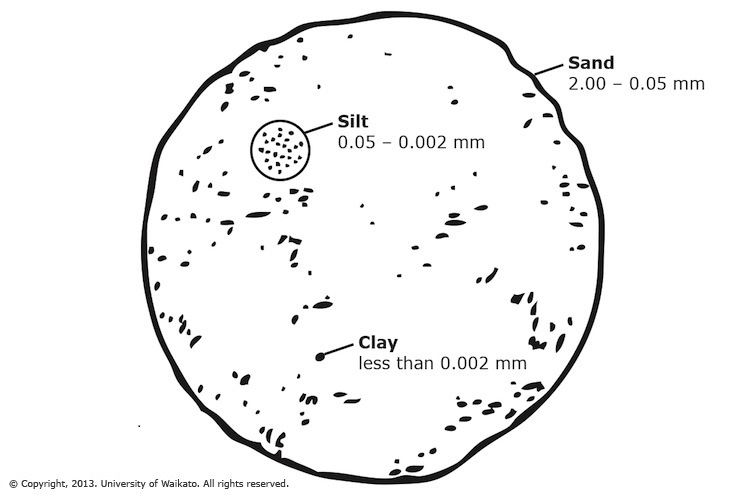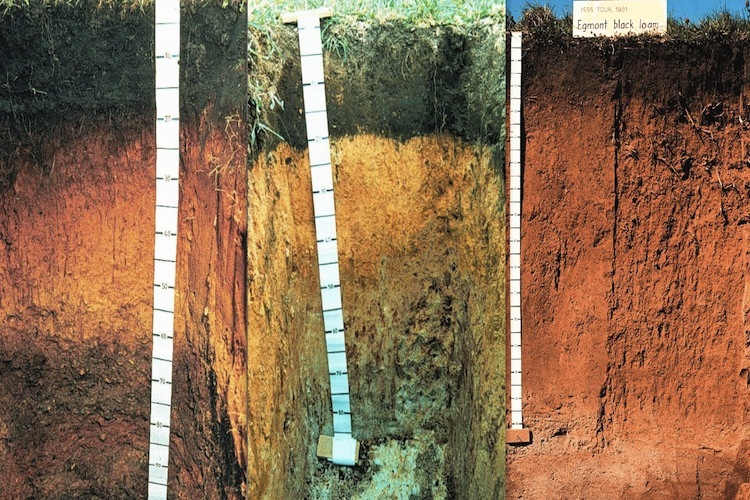All soils contain mineral particles, organic matter, water and air. The combinations of these determine the soil’s properties – its texture, structure, porosity, chemistry and colour.
Soil texture
Soil is made up of different-sized particles. Soil texture refers to the size of the particles that make up the soil and depends on the proportion of sand, silt and clay-sized particles and organic matter in the soil. Sandy soils feel gritty when rubbed between your fingers. Silts feel smooth – a little like flour. Most clays are sticky and mouldable. If you’ve ever used pottery clay, you’ll know the feeling.
Soils are made up of different combinations of sand, silt and clay particles. Soils that are a mixture of sand, silt and clay are called loams. The name of the soil often identifies the dominant particle, for example, Timaru silt loam describes a soil that has a predominance of silt. Other examples of New Zealand soils are Waikare clay and Te Kopuru sand.
Soil texture can influence whether soils are free draining, whether they hold water and how easy it is for plant roots to grow.
- Sand particles are quite big. The pore spaces between the particles in sandy soils are also quite large. This allows water to drain quickly and air to enter the soil. Sandy soils tend not to get waterlogged in winter but can be subject to drought during summer.
- Silt particles are too small for us to see with our eyes. Silt soils have much smaller pore spaces but a lot more of them.
- Clay particles are smaller than 0.002 mm in diameter. Clay soils are poorly drained and hold on to the water in their pore spaces for much longer. However, they can become very hard if they dry out.
Soil structure
Soil structure describes the way the sand, silt and clay particles are clumped together. Organic matter (decaying plants and animals) and soil organisms like earthworms and bacteria influence soil structure. Clays, organic matter and materials excreted by soil organisms bind the soil particles together to formaggregates. Soil structure is important for plant growth, regulating the movement of air and water, influencing root development and affecting nutrient availability. Good quality soils are friable (crumbly) and have fine aggregates so the soil breaks up easily if you squeeze it. Poor soil structure has coarse, very firm clods or no structure at all.
Soil porosity
Soil porosity refers to the pores within the soil. Porosity influences the movement of air and water. Healthy soils have many pores between and within the aggregates. Poor quality soils have few visible pores, cracks or holes. The way in which a soil is managed can affect its porosity. For example, look at areas around your school where students regularly walk. If the grass is worn away and the soil is exposed, it often looks different because it has been compacted and has had its structure and porosity altered. These are also areas where puddles form because the water is not able to drain away.
Soil chemistry
Clays and organic matter in the soil carry negative charges. Water in the soil dissolves nutrients and other chemicals. Nutrients like potassium and ammoniumhave positive charges. They are attracted to the negatively charged organic and mineral matter, and this prevents them from being lost through leaching as water moves through the soil. Nitrate has a negative charge so it is not protected from leaching in most soils.
Soils can be acid, alkaline or neutral. Soil pH influences nutrient absorption and plant growth. Some plants, like kūmara and potatoes, grow best in a more acidic soil (pH of 5.0–6.0). Carrots and lettuces prefer soils with a neutral pH of 7.0. Soils can become more acidic over time as minerals are leached away. Lime is often added to soil to make it less acidic. New Zealand paddocks are regularly limed to improve pasture growth.
Soil colour
If you thought that all soils are brown, think again. Soil colours range from black to red to white. Sometimes it can even be blue! Soil colour mostly comes from organic matter and iron. Topsoil is often dark because of organic matter. An even, single colour indicates the soil is well drained. In contrast, rusty spots and grey patches (sometimes even a light blue in colour) indicate poor drainage.
Nature of science
To communicate in science, we need to use correct terms, vocabulary and conventions. One of the conventions involves the use of ancient Greek or Latin words to develop new terms. For example, pedology is the scientific study of soils. The name comes from two Greek words – ‘pedon’ meaning soil and ‘logos’ meaning study.


No comments:
Post a Comment